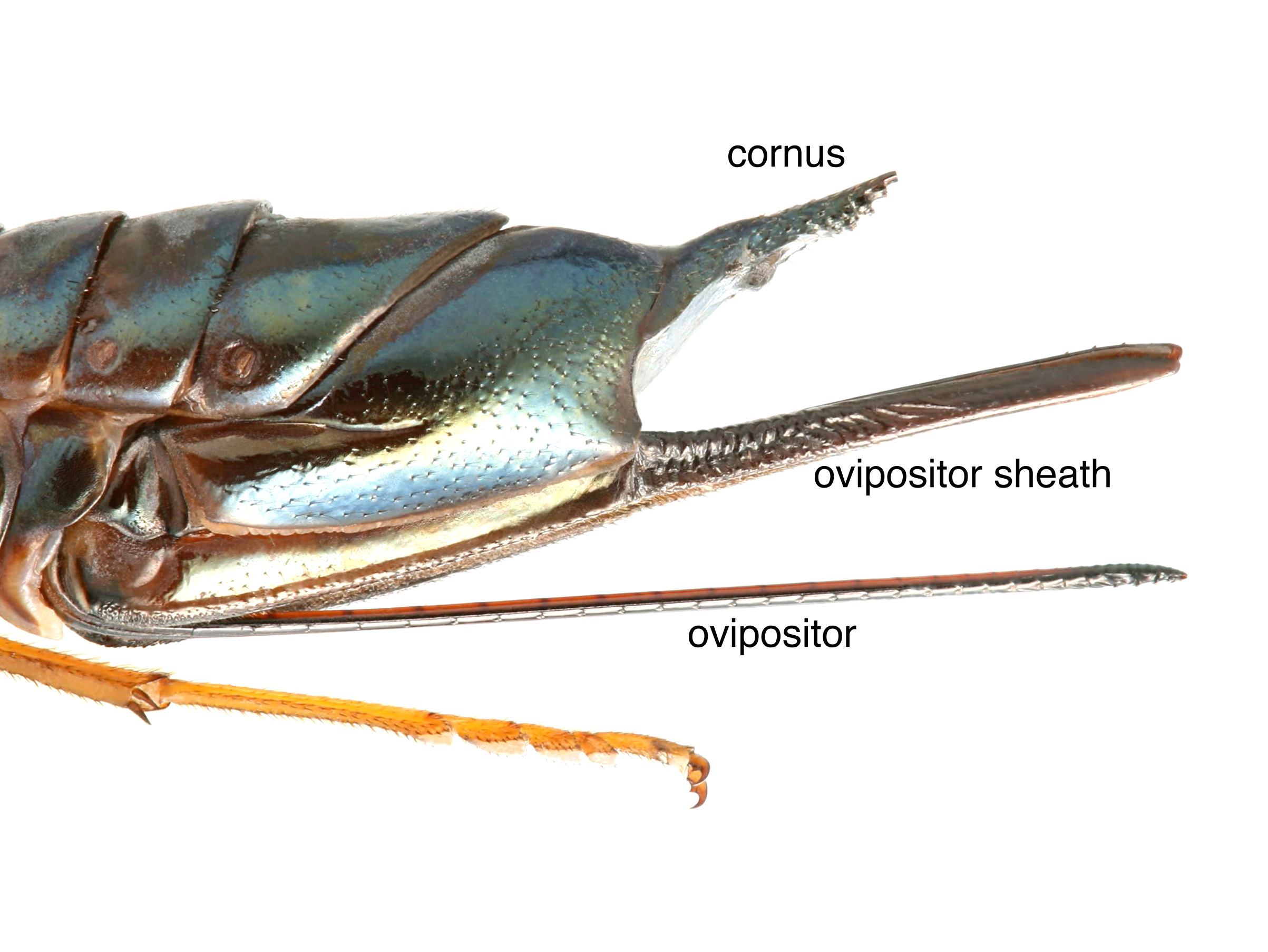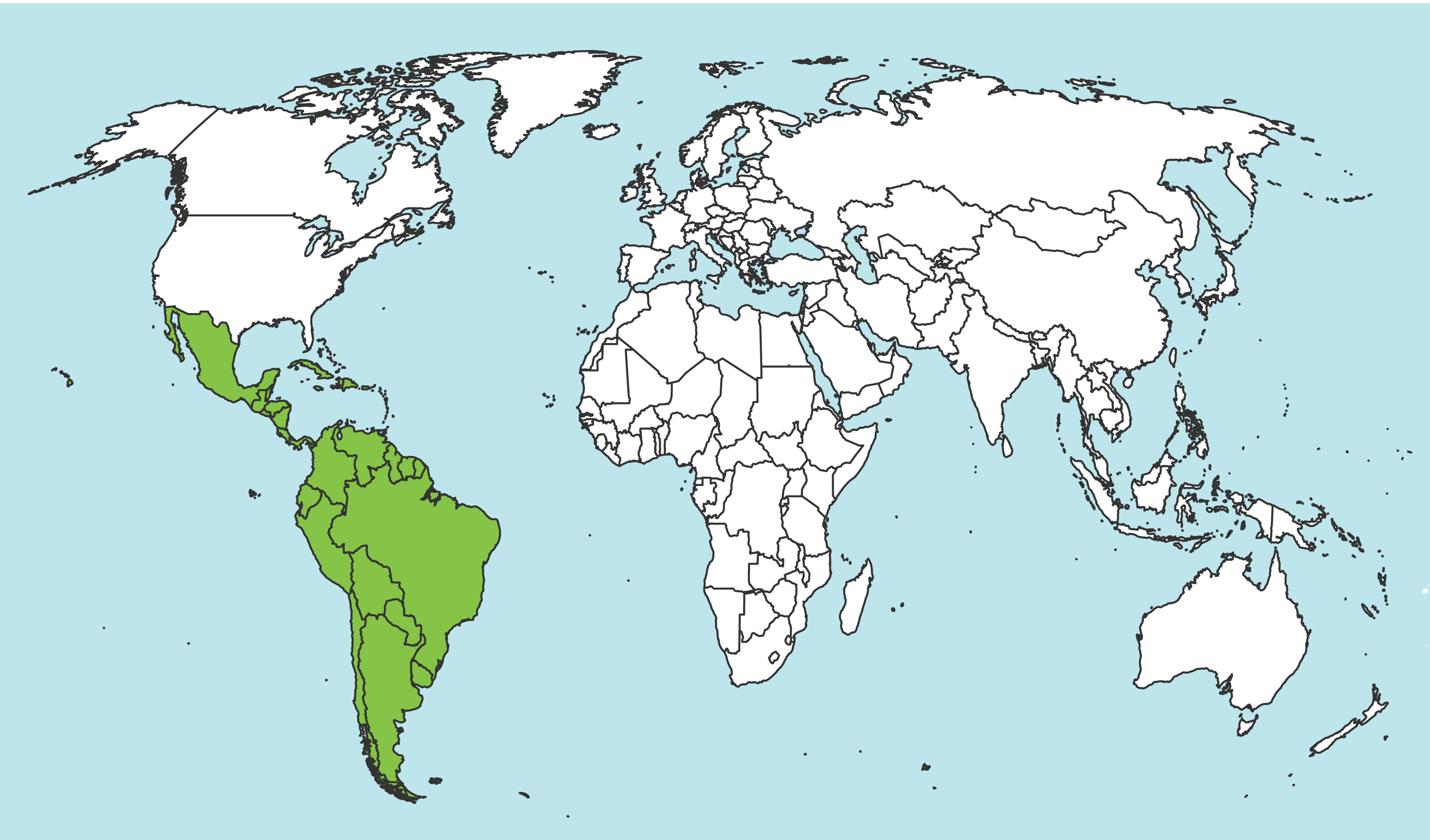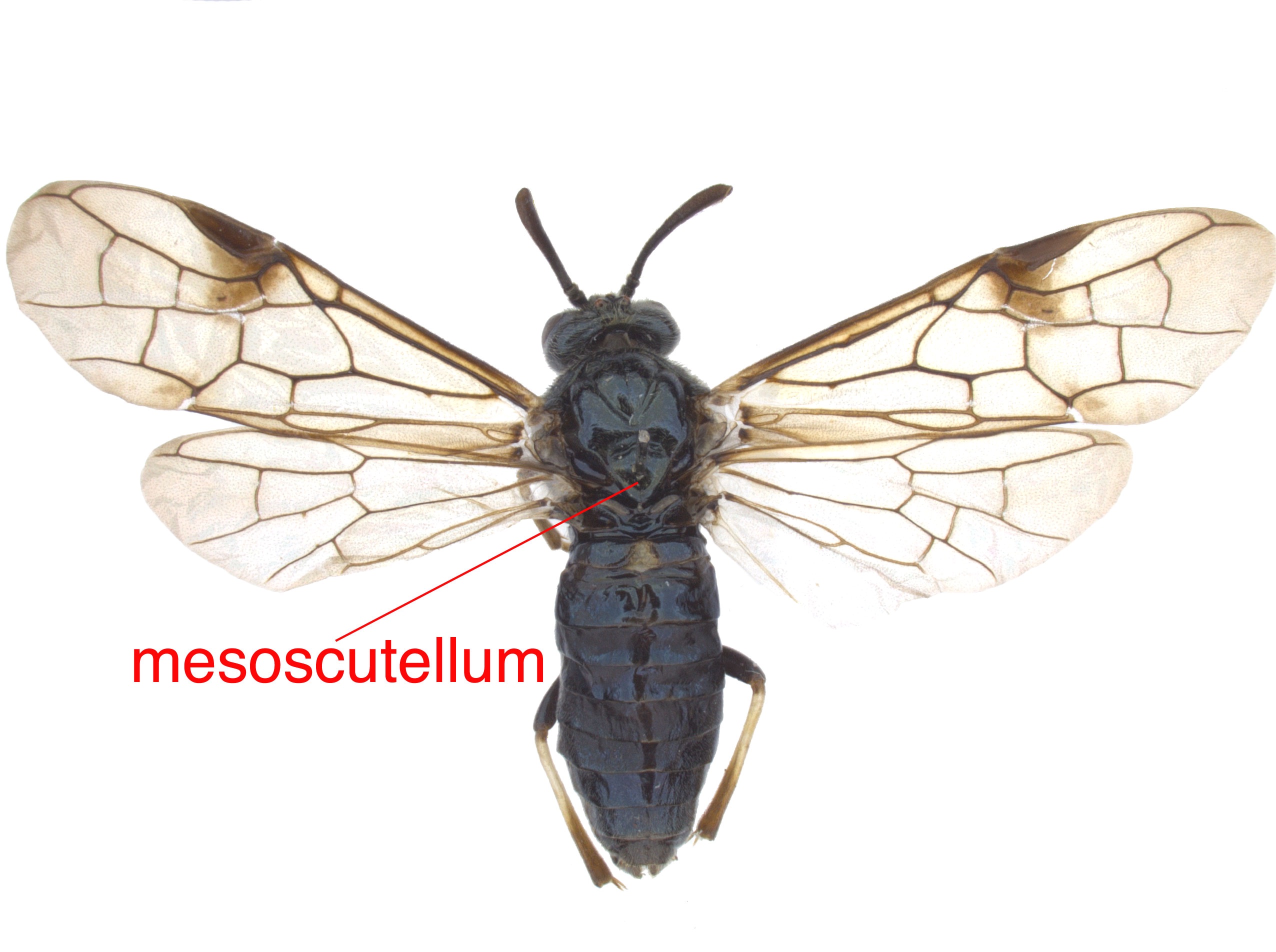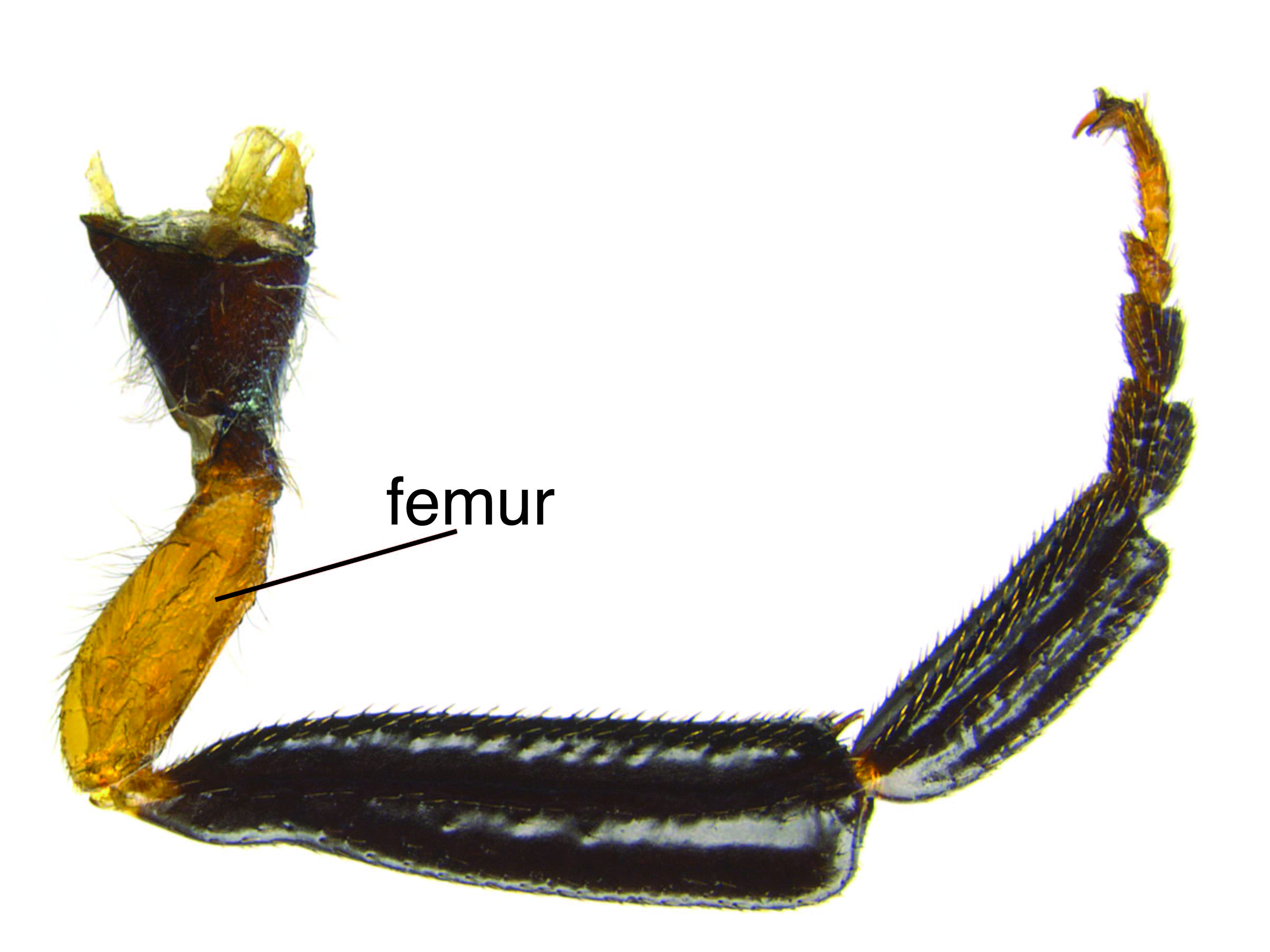Family: Orussidae
Family common name: parasitic woodwasps
Subfamily: Orussinae
Genus: Orussus Latreille, 1797
Subgenera: none
The Orussidae are small, predominantly black sawflies with cylindrical bodies and globular heads (Eaton and Kaufman 2007Eaton and Kaufman 2007:
Eaton ER and Kaufman K. 2007. Kaufman Field Guide to Insects of North America (Kaufman Field Guides). Houghton Mifflin Harcourt. 391 pp.). They are distinctive because they are the only sawfly family that is parasitic instead of phytophagousphytophagous:
feeding on plants
(Furniss and Carolin 1977Furniss and Carolin 1977:
Furniss RL and Carolin VM. 1977. Western forest insects. United States Deptartment of Agriculture Forest Service Miscellaneous Publication 1339: 1-655.). Current Hymenoptera phylogenies suggest that the Orussidae are the most closely related extantextant:
in existence; opposite of extinct
sawfly family to the suborder Apocrita, and specifically parasitic wasps (Vilhelmsen 2004Vilhelmsen 2004:
Vilhelmsen L. 2004. The old wasp and the tree: fossils, phylogeny, and biogeography in the Orussidae (Insecta, Hymenoptera). Biological Journal of the Linnaen Society 82: 139-160.).
Orussus are 5–14 mm in length (Furniss and Carolin 1977Furniss and Carolin 1977:
Furniss RL and Carolin VM. 1977. Western forest insects. United States Deptartment of Agriculture Forest Service Miscellaneous Publication 1339: 1-655.). They share several remarkable morphological characters with other Orussidae, including antennal insertions located extremely low on the face, reduced wing venationvenation:
the network of veins on a wing
, and a relatively long and thin ovipositorovipositor:
the female organ that deposits eggs and is used to drill into plant tissue, located at the apex of the abdomen, made up of the lance and lancet
 (Vilhelmsen et al. 2014Vilhelmsen et al. 2014:
(Vilhelmsen et al. 2014Vilhelmsen et al. 2014:
Vilhelmsen L, Blank SM, Liu Z, and Smith DR. 2014. Discovery of a new species confirms Oriental origin of Orussus Latrielle (Hymenoptera: Orussidae). Insect Systematics and Evolution 45: 51-91. https://doi.org/10.1163/1876312X-00002087). Though it is the most speciosespeciose:
describing a taxon that includes a high number of species
and widespread of the family, collections of this genus are uncommon (Vilhelmsen et al. 2014Vilhelmsen et al. 2014:
Vilhelmsen L, Blank SM, Liu Z, and Smith DR. 2014. Discovery of a new species confirms Oriental origin of Orussus Latrielle (Hymenoptera: Orussidae). Insect Systematics and Evolution 45: 51-91. https://doi.org/10.1163/1876312X-00002087).
Worldwide, there are 28 extantextant:
in existence; opposite of extinct
described species (Choi et al. 2014Choi et al. 2014:
Choi JK, Wei M, Vilhelmsen L, and Lee JW. 2014. A new Orusses species from South Korea, and a key to the East Asian Orussidae (Hymenoptera). Zootaxa 3873 (3): 250-258. https://doi.org/10.11646/zootaxa.3873.3.4). The lowest diversity is in the Southern Hemisphere, with only six species recorded from the NeotropicalNeotropical:
Describing the region of the Western Hemisphere that is tropical, ie. between 30°N and 30°S of the equator; includes southern Mexico, Central America, the Caribbean and South America
 , African, and Australasian regions (Vilhelmsen et al. 2014Vilhelmsen et al. 2014:
, African, and Australasian regions (Vilhelmsen et al. 2014Vilhelmsen et al. 2014:
Vilhelmsen L, Blank SM, Liu Z, and Smith DR. 2014. Discovery of a new species confirms Oriental origin of Orussus Latrielle (Hymenoptera: Orussidae). Insect Systematics and Evolution 45: 51-91. https://doi.org/10.1163/1876312X-00002087). Five species occur in North America (Middlekauff 1983Middlekauff 1983:
Middlekauff WW. 1983. A revision of the sawfly family Orussidae for North and Central America (Hymenoptera: Symphyta, Orussidae). University of California Publications in Entomology 101: 1-46.).
A key to North and Central American species of Orussus is included in Middlekauff 1983Middlekauff 1983:
Middlekauff WW. 1983. A revision of the sawfly family Orussidae for North and Central America (Hymenoptera: Symphyta, Orussidae). University of California Publications in Entomology 101: 1-46..
 (Middlekauff 1983Middlekauff 1983:
(Middlekauff 1983Middlekauff 1983: longer than body length and thread-like; when withdrawn, ovipositorovipositor:
longer than body length and thread-like; when withdrawn, ovipositorovipositor: hidden inside the body, sometimes coiled (Middlekauff 1983Middlekauff 1983:
hidden inside the body, sometimes coiled (Middlekauff 1983Middlekauff 1983: ; distaldistal:
; distaldistal: as long as combined length of the third and fourth (Goulet 1992Goulet 1992:
as long as combined length of the third and fourth (Goulet 1992Goulet 1992: M of fore wingfore wing:
M of fore wingfore wing: does not reach veinvein:
does not reach veinvein: R but; veinvein:
R but; veinvein: M longer than veinvein:
M longer than veinvein: 1m-cu (Goulet 1992Goulet 1992:
1m-cu (Goulet 1992Goulet 1992: coming to a sharp angle at apexapex:
coming to a sharp angle at apexapex:Orussidae are morphologically distinct among sawfly families because of the body shape and location of antennaeantenna:
the sensory organ emerging from the front of the head, usually between the compound eyes and above the clypeus; includes the flagellum, scape and pedicel
 on head. Orussus, however, is easily confused with other genera of the family. It can be distinguished by a lack of longitudinal carinaecarina:
on head. Orussus, however, is easily confused with other genera of the family. It can be distinguished by a lack of longitudinal carinaecarina:
a ridge or raised edge
 on the face between the compound eyes, lack of swelling on the hind femorafemur:
on the face between the compound eyes, lack of swelling on the hind femorafemur:
the third segment of the leg between the trochanter and the tibia
 , and the shield-shaped mesoscutellummesoscutellum:
, and the shield-shaped mesoscutellummesoscutellum:
the anterior section of the scutellum
 (Middlekauff 1983Middlekauff 1983:
(Middlekauff 1983Middlekauff 1983:
Middlekauff WW. 1983. A revision of the sawfly family Orussidae for North and Central America (Hymenoptera: Symphyta, Orussidae). University of California Publications in Entomology 101: 1-46.).
none
In North America, Orussus are parasitoids that feed on wood-boring beetles of Buprestidae (Vilhelmsen et al. 2014Vilhelmsen et al. 2014:
Vilhelmsen L, Blank SM, Liu Z, and Smith DR. 2014. Discovery of a new species confirms Oriental origin of Orussus Latrielle (Hymenoptera: Orussidae). Insect Systematics and Evolution 45: 51-91. https://doi.org/10.1163/1876312X-00002087). Species used as host include Buprestis aurulenta, Buprestis confluenta, Buprestis laeviventris, Buprestis rufipes, Chrysophana placida, Dicera divaricate and Polycesta californica (Middlekauff 1983Middlekauff 1983:
Middlekauff WW. 1983. A revision of the sawfly family Orussidae for North and Central America (Hymenoptera: Symphyta, Orussidae). University of California Publications in Entomology 101: 1-46.).
The recorded “host” trees of North American Orussus, which are more likely to be the hosts of parasitized beetles, include Abies concolor (white fir), Abies magnifica (red fir), Acer rubrum (red maple), Acer saccharum (sugar maple), Acer macrophyllum (big leaf maple), Alnus sp. (alder), Betula occidentalis (water birch), Carya sp. (hickory), Fraxinus sp. (ash), Larix laricina (tamarack), Malus pumila (apple), Picea sitchensis (Sitka spruce), Pinus contorta (lodgepole pine), Pinus jeffreyi (Jeffrey pine), Pinus monticola (western white pine), Pinus ponderosa (ponderosa pine), Pseudotsuga menziesii (Douglas fir), Populus fremontii (Fremont cottonwood), Populus tremuloides (quaking aspen), Quercus californicus (California black oak), Tilia americanum (basswood) and Ulmus americanus (American elm) (Middlekauff 1983Middlekauff 1983:
Middlekauff WW. 1983. A revision of the sawfly family Orussidae for North and Central America (Hymenoptera: Symphyta, Orussidae). University of California Publications in Entomology 101: 1-46.).
To find a suitable oviposition site, Orussus females run up and down fallen or standing dead or damaged tree trunks, using their antennaeantenna:
the sensory organ emerging from the front of the head, usually between the compound eyes and above the clypeus; includes the flagellum, scape and pedicel
 to tap repetitively on the log. The behavior of running up and down, with the wings folded and effectively hidden, superficially resembles the behavior of carpenter ants. In the field, these females have been observed spending up to 27 minutes on the same log patrolling for an oviposition site. Whether they are able to sense a host presence in the log by chemical signals or by vibrations caused by the tapping of antennaeantenna:
to tap repetitively on the log. The behavior of running up and down, with the wings folded and effectively hidden, superficially resembles the behavior of carpenter ants. In the field, these females have been observed spending up to 27 minutes on the same log patrolling for an oviposition site. Whether they are able to sense a host presence in the log by chemical signals or by vibrations caused by the tapping of antennaeantenna:
the sensory organ emerging from the front of the head, usually between the compound eyes and above the clypeus; includes the flagellum, scape and pedicel
 is unclear (Powell and Turner 1975Powell and Turner 1975:
is unclear (Powell and Turner 1975Powell and Turner 1975:
Powell JA and Turner WJ. 1975. Observations on oviposition behavior and host selection in Orussus occidentalis (Hymenoptera: Siricoidea). Journal of the Kansas Entomological Society 48 (3): 299-307.).
Females oviposit into an established, frass-filled gallery, 5–15 cm away from a wood-boring insect larvalarva:
the immature stage of holometabolous insects
 . After hatching, the Orussus larvalarva:
. After hatching, the Orussus larvalarva:
the immature stage of holometabolous insects
 moves down the mine, sometimes feeding on frassfrass:
moves down the mine, sometimes feeding on frassfrass:
solid larval excrement
, before beginning to feed as an external parasitoid on the wood-borer (Middlekauff 1983Middlekauff 1983:
Middlekauff WW. 1983. A revision of the sawfly family Orussidae for North and Central America (Hymenoptera: Symphyta, Orussidae). University of California Publications in Entomology 101: 1-46.). LarvaeLarva:
the immature stage of holometabolous insects
 are white, legless, and grub-like. The body is slightly flattened and tapers on either end (Vilhelmsen et al. 2014Vilhelmsen et al. 2014:
are white, legless, and grub-like. The body is slightly flattened and tapers on either end (Vilhelmsen et al. 2014Vilhelmsen et al. 2014:
Vilhelmsen L, Blank SM, Liu Z, and Smith DR. 2014. Discovery of a new species confirms Oriental origin of Orussus Latrielle (Hymenoptera: Orussidae). Insect Systematics and Evolution 45: 51-91. https://doi.org/10.1163/1876312X-00002087).
World: Representatives of Orussus are present in Europe, North America, Southwest, East and Southeast Asia, tropical Africa, the Philippines, and New Guinea (Middlekauff 1983Middlekauff 1983:
Middlekauff WW. 1983. A revision of the sawfly family Orussidae for North and Central America (Hymenoptera: Symphyta, Orussidae). University of California Publications in Entomology 101: 1-46.)
North America: The species of Orussus in North America are mostly recorded from two distinct ranges, east and west - there are very few records for the plains states and provinces. The eastern range spans from Quebec and New England, south to Louisiana, and as far west as Ohio and Illinois. The western range includes British Columbia south to California, as far east as Ontario in the north, and some collections as far east as New Mexico in the south (Middlekauff 1983Middlekauff 1983:
Middlekauff WW. 1983. A revision of the sawfly family Orussidae for North and Central America (Hymenoptera: Symphyta, Orussidae). University of California Publications in Entomology 101: 1-46.).
Map data from: GBIF.org (26 June 2019) GBIF Occurrence Download Orussus
Details about data used for maps can be found here.